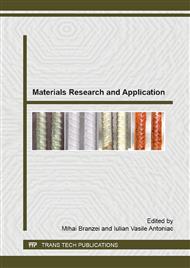p.149
p.155
p.160
p.166
p.172
p.183
p.190
p.196
p.206
Thermophysical Properties in Assembling Process at Macro and Micro Level
Abstract:
The electronic modules are complex ensemble of electronic components having terminals (PIN) connected by solder joints on dedicated metallic surfaces (PAD) parts of conductive interconnection structure realized on rigid or flexible dielectric substrate having different core materials. The reliability of the electronic modules could be considered as expression of solder joints functionality (SJF) relating to working conditions and unique defined by their electrical, mechanical and thermal properties. These properties are in close connection with the solder joints microstructures, result of the soldering Process temperature gradient action over the trinomial solder alloy Paste, Pin and Pad. Consequently the solder joints quality can be correctly evaluated taking into consideration not only the severally intrinsic parameters of the trinomial elements Pin-Pad-Paste characterized by specific thermophysical properties (ThP), but also interrelate the complex reaction at the interface between them and interdependence with the soldering Process parameters.In the paper, will be analyzed the influencing factors of manufacturing processes, the most important assembling defects at macro and micro level, their causes relating to specific ThP and processes at interfaces Pin-solder joints-Pad, it will be identify the Key Process Input Variables (KPIV) and propose a structural model for assembling processes, 4P Soldering Model, as an useful tool in engineering of electronic product in order to assure the assumed goal for assembling stage.
Info:
Periodical:
Pages:
172-179
Citation:
Online since:
July 2015
Authors:
Price:
Сopyright:
© 2015 Trans Tech Publications Ltd. All Rights Reserved
Share:
Citation:


